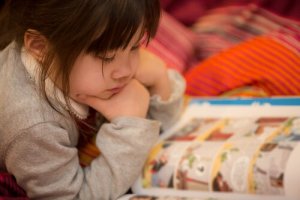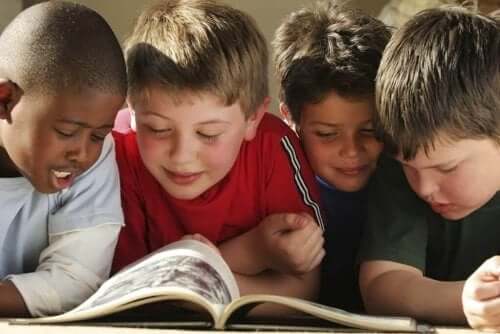Comic Books: A Great Type of Reading Material for Children

Toon Books, Tiny Titans, Scooby-Doo… You probably recognize these beloved characters. And, surely, you also know what they all have in common: they’re characters created for comic books.
We decided to talk about comic books today because they’re completely different reading materials that attract children’s attention due to their structure, history, and the characteristics of their characters.
The characteristics of comic books
For many years, comic books have become part of children’s literature. These books have very distinct characteristics. These are stories that develop their plot through a succession of images, which are complemented with the text.
Unlike other types of children’s literature, comic books always have the same structure:
- A sequence of images that include panels of text.
- These panels include speech balloons that point to the character who’s saying those words.
- The permanence of, at least, one same character throughout the sequence of panels.
In comic book panels, the reader is always in the present, while the previous ones belong to the past, and the next ones to the future.
The importance of speech balloons
Besides their structure, one of the elements that characterize comic books is speech balloons. Without them, you wouldn’t know which character is speaking. Therefore, the thread of the story would break. These speech balloons are composed of two parts:
- The part that shows the text, called a balloon.
- The part that’s pointing to the character who’s speaking, called the tail.
In this regard, the importance of speech balloons also lies in their shape, as they change as the plot progresses. The shape varies depending on the mood or feeling the character wants to express:
- Shaped like a cloud – a character’s thoughts.
- Shaped like a saw – phrase that expresses anger and screams.
- Expanded drop of water – expresses fear or cold.
- A speech balloon with several tails indicates that several characters are saying the text at the same time.
The use of onomatopoeia
Onomatopoeia is the use of words that imitate or recreate particular sounds. This resource is ideal for stories where everything is condensed in small spaces, as each of the speech balloons have very limited space.
In addition, onomatopoeia emphasizes storytelling, making it more credible for children. In addition, they can even recreate the sounds themselves.
The purpose of comic books
While it’s true that, at first, this type of reading material was created in order to distract the reader and also provide a new way of reading for fun, now their purpose has expanded.
Due to the social needs of the era when comics were created (they emerged approximately in 1820), comic books began to have a didactic purpose.
Today, although their goal is still to amuse and entertain children, every story shares a lesson or moral.
The best comic books for children
Due to the autonomy these stories offer children, as well as simplicity and fun, comic books have consecrated in children’s literature.
Although characters such as Mafalda or Spider-Man remain a benchmark of these books, new characters and new stories now entertain and teach children. Below, we’ll share some of the best.

1. Ana and Froga
A group of friends and a frog are the stars of these comic books. We’re sure they’ll delight children! It’s a very wise choice for children who are beginning to read.
2. Comic books without text
This is undoubtedly one of the best options, especially for children who don’t know how to read and those who do know but like to develop their imagination. These stories have no texts.
You can find many different ones out there!
3. The Hilda graphic novel series
A girl’s adventure and curiosity are the elements that make this comic book collection one of the most successful. This graphic novel series is recommended for both children and adults due to how immersive its stories are.
Toon Books, Tiny Titans, Scooby-Doo… You probably recognize these beloved characters. And, surely, you also know what they all have in common: they’re characters created for comic books.
We decided to talk about comic books today because they’re completely different reading materials that attract children’s attention due to their structure, history, and the characteristics of their characters.
The characteristics of comic books
For many years, comic books have become part of children’s literature. These books have very distinct characteristics. These are stories that develop their plot through a succession of images, which are complemented with the text.
Unlike other types of children’s literature, comic books always have the same structure:
- A sequence of images that include panels of text.
- These panels include speech balloons that point to the character who’s saying those words.
- The permanence of, at least, one same character throughout the sequence of panels.
In comic book panels, the reader is always in the present, while the previous ones belong to the past, and the next ones to the future.
The importance of speech balloons
Besides their structure, one of the elements that characterize comic books is speech balloons. Without them, you wouldn’t know which character is speaking. Therefore, the thread of the story would break. These speech balloons are composed of two parts:
- The part that shows the text, called a balloon.
- The part that’s pointing to the character who’s speaking, called the tail.
In this regard, the importance of speech balloons also lies in their shape, as they change as the plot progresses. The shape varies depending on the mood or feeling the character wants to express:
- Shaped like a cloud – a character’s thoughts.
- Shaped like a saw – phrase that expresses anger and screams.
- Expanded drop of water – expresses fear or cold.
- A speech balloon with several tails indicates that several characters are saying the text at the same time.
The use of onomatopoeia
Onomatopoeia is the use of words that imitate or recreate particular sounds. This resource is ideal for stories where everything is condensed in small spaces, as each of the speech balloons have very limited space.
In addition, onomatopoeia emphasizes storytelling, making it more credible for children. In addition, they can even recreate the sounds themselves.
The purpose of comic books
While it’s true that, at first, this type of reading material was created in order to distract the reader and also provide a new way of reading for fun, now their purpose has expanded.
Due to the social needs of the era when comics were created (they emerged approximately in 1820), comic books began to have a didactic purpose.
Today, although their goal is still to amuse and entertain children, every story shares a lesson or moral.
The best comic books for children
Due to the autonomy these stories offer children, as well as simplicity and fun, comic books have consecrated in children’s literature.
Although characters such as Mafalda or Spider-Man remain a benchmark of these books, new characters and new stories now entertain and teach children. Below, we’ll share some of the best.

1. Ana and Froga
A group of friends and a frog are the stars of these comic books. We’re sure they’ll delight children! It’s a very wise choice for children who are beginning to read.
2. Comic books without text
This is undoubtedly one of the best options, especially for children who don’t know how to read and those who do know but like to develop their imagination. These stories have no texts.
You can find many different ones out there!
3. The Hilda graphic novel series
A girl’s adventure and curiosity are the elements that make this comic book collection one of the most successful. This graphic novel series is recommended for both children and adults due to how immersive its stories are.
All cited sources were thoroughly reviewed by our team to ensure their quality, reliability, currency, and validity. The bibliography of this article was considered reliable and of academic or scientific accuracy.
- Ricard, A. (2013). Ana y Froga. Blackie Books.
- Mora, S. (2009). La caca mágica. Bang Ediciones.
- Pearson, L. (2013). Hilda y el trol. Barbara Fiore Editora.
- Ortiz Gutiérrez, J. (2009). EL CÓMIC COMO RECURSO DIDÁCTICO EN LA EDUCACIÓN PRIMARIA. Temas Para La Educación Revista Digital Para Profesionales de La Enseñanza.
This text is provided for informational purposes only and does not replace consultation with a professional. If in doubt, consult your specialist.








